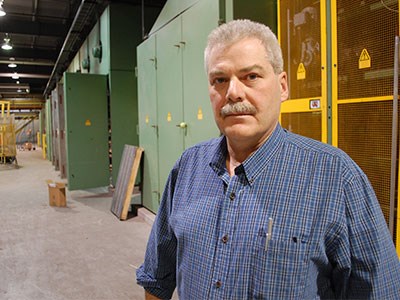The sight of steam emanating from the boilers and lofting out the stack at the Rutherglen mill for the first time in five years was almost greeted like papal smoke signals by Mattawa area locals in February.
The pent-up anticipation behind the spring restart of the Columbia Forest Products veneer plant has been so great, manager Peter Loy keeps the chain on the gate to prevent hopeful job seekers from entering the premises to drop off resumés.
“We’re not manned up to greet everyone,” said Loy, who’s well aware of the buzz it’s created in the rural northeastern Ontario community located halfway between North Bay and Mattawa.
It’s an especially good feeling for Loy, who began his career on the same production floor in 1982, before progressing up the ranks to become plant manager just prior to the 2010 shutdown.
Back then, North American veneer producers were being hammered by cheap Chinese imports at the same time the U.S. housing market took a dive.
Efficiencies were good at the Rutherglen mill, outfitted with a top-of-the-line rotary lathe and a state-of-the-art German-made dryer, but with the Canadian dollar at par and operating costs high in Ontario, the cost structure to keep going was not.
Columbia shuttered the mill, laying off 55, but it didn’t completely walk away. The company held onto the asset with the intention to re-evaluate the business in three to five years.
With the homebuilding market on more solid footing, Columbia is pumping US$1.5 million into the sprawling 100,000-square-foot plant as a skeleton crew of current and former employees was refurbishing equipment in early February.
Not much structurally had to be repaired, said Loy, of the almost pristine, embryonic state the machinery and infrastructure were left in.
“The guys did a wonderful job of putting it to bed five years ago and prepping it to sit. They’ve done a really good of taking care of the place.”
Loy has set an unspecified April startup date, beginning with 25 employees cutting and drying hardwood veneer on a single shift.
“Walk before you run.”
More value-added activities, like reviving the splicing department, could happen toward year’s end.
He declined to reveal first-year production numbers or the mill’s capacity except to say they’ll run at a 60 per cent pace initially before ramping up to a normal rate over three months.
“So much depends on what markets are going to do.”
He describes North American veneer demand as “murky” for 2016, but obviously the market appetite has improved to where it’s feasible for Columbia to restart production.
The main product will be a four-by-eight sheet, which comes off their rotary lathe “like a heavy paper” at 1/25th of an inch. It’s used for cabinetry and other architectural products.
Two-thirds of Rutherglen’s production will head to Columbia’s plywood mills in the U.S., Hearst and an associated mill in Quebec.
With no Crown wood allotment for the mill, agreements are being negotiated to buy veneer logs on the open market. Some will be sourced from stakeholders on nearby forest management units and sawmills in the region.
“We’ll take veneer logs wherever we can find them,” said Loy.
They’ll need some rolling stock, too, like a log truck for the yard and some folk lifts. Many industrial suppliers are only too happy to help them.
“We’ve opened accounts with quite a number of them,” said Loy. “Our needs right now are primarily maintenance parts. As we go into production, we’ll open up all the avenues we had before.”
Some key people are already aboard, including a chief electrician and two experienced millwrights.
“We’re in the process of trying to source operating engineers to run our boilers and we’ll need a chief operating engineer,” said Loy.
Filling out the roster shouldn’t be a problem since many former employees were long-distance commuting to contracting jobs in the Alberta oilsands, and have expressed an interest in returning.
A limited number of entry-level production positions will also be available.
Though they’ve advertised positions, the company is not yet accepting resumés, turning that duty over to the Mattawa Bonfield Economic Development Corporation.
“We’re not looking at sourcing our manpower from the production end until end of February and March,” said Loy.
Since last fall, Jeff McGirr, director of economic development, has been compiling a forestry employment database for potential employers to cherry pick.
Word of mouth has swelled the skills bank to more than 200 individuals from the immediate area, North Bay, Deep River, Temagami, South River and Sturgeon Falls.
“The advantage is the oilsands has provided us with this incredibly well-trained and adaptable employment base,” said McGirr. “These are highly, highly skilled and experienced individuals.”




